The AMD Ryzen Threadripper 1950X and 1920X Review: CPUs on Steroids
by Ian Cutress on August 10, 2017 9:00 AM ESTPower Consumption and Distribution
With Threadripper weighing in at a TDP of 180W, it comes across as a big jump from previous AMD platforms that hover at 45-95W, or Intel platforms that are sub-95W for mainstream and up to 140W for the high-end desktop. Let us not forget that AMD actually released a 220W TDP processor in the form of the FX-9590 running at 5 GHz, which was initially sold for 12+ months as a part purely for OEMs and system integrators in order to ensure that users had sufficient cooling. Eventually it was released as a consumer product, bundled with a beefy double width liquid cooler and a pair of fans. AMD sampled us a CPU, not before I went and spent £300 on one myself and reviewed it:
Nonetheless, 180W for AMD isn’t a new concept for TDP. For this review I’ve been using the liquid cooler AMD shipped with our FX-9590 sample, because it was designed to handle at least 220W. (AMD also sampled a 3x120 Thermaltake cooler with Threadripper, which would have taken a lot longer to organise on the test bed.)
For our power testing, we run Prime95 for at least 60 seconds then use software to poll the integrated power counters on the chip to get results. Depending on the CPU, we can get data for the full chip, per core, DRAM, uncore or integrated graphics – it relies on our tool being up to date or the registers for this data to be known. Normally this way of reading the power consumption can be a smidge inaccurate compared to more invasive methods, it is quick and scriptable, and it is this data that governs if and when a CPU is hitting power limits and needs to adjust fan speeds/frequencies to compensate.
To start, let us take the full package power consumption for Threadripper.
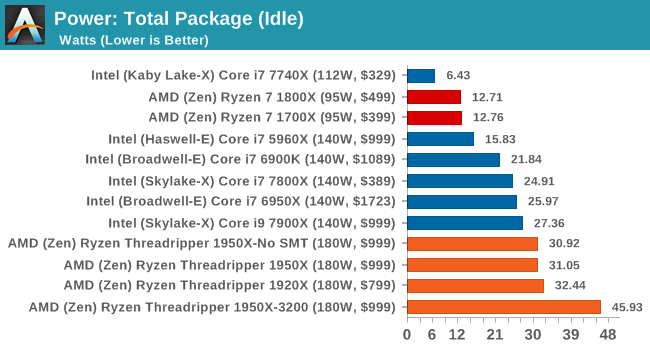
On the whole, Threadripper is a hungry chip even at idle. Most of the power here is being consumed by the memory controller and PCIe bus to keep the GPU ticking over with a static display. The fact that the 1950X running DDR4-3200 memory is pulling another 13W+ from the CPU shows how much of an impact the memory controller has on total power consumption. For all the chips, we’re recording sub 2W power draw from the cores.
When we load up the package with a single thread, it fires up the uncore/mesh as well as the memory and puts the system into its peak turbo state. Depending on the way the CPU is designed, this could fire up a single core or a bank of cores, so although in a bank of cores only one will be doing the work, it can still train power to be noticeable.
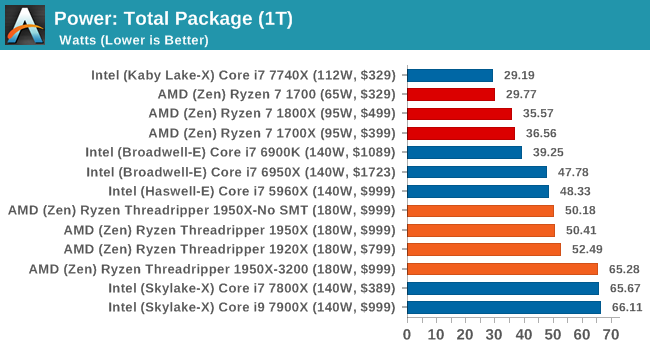
The results show all the Threadripper CPUs again hitting around the same mark, well above the Ryzen CPUs, and matching the 10C/8C parts from Broadwell-E and Haswell-E respectively. The 1950X running DDR4-3200 is still pulling an additional +13W, but interestingly the Skylake-X cores have jumped in power consumption to around this level. It would appear that the MoDe-X interconnect used in Skylake-X can also draw substantial power.
The next test is running the CPU will a full complement of threads for the design of the chip. This usually puts maximum strain on all the cores, the interconnect and the memory controller.
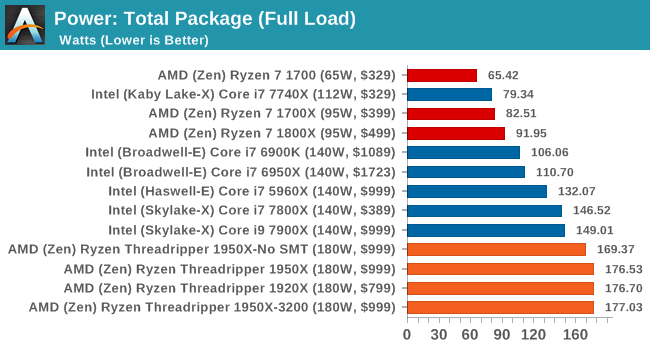
All the Threadripper CPUs hit around 177W, just under the 180W TDP, while the Skylake-X CPUs move to their 140W TDP. The 1950X in Game Mode seems to draw a little less power, which might be due to how the DRAM is being run in a NUMA environment.
One of the other graphs we have for some of the chips is the ‘cores-only’ power draw. At full load, we get an interesting plot:
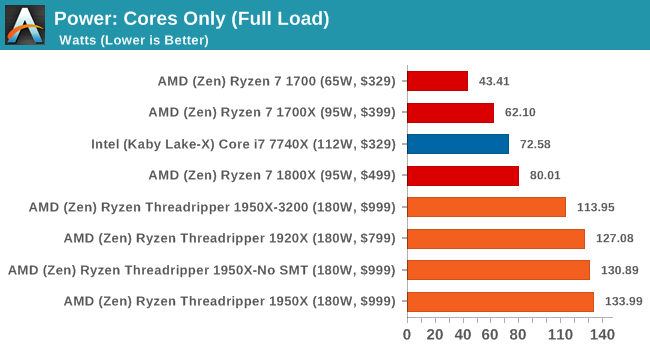
The key element to this graph is the 1950X running at DDR4-3200. Because the faster DRAM requires the memory controller to draw more power, it leaves less power for the CPU cores, potentially resulting in a lower turbo core frequency. So while the faster memory might guarantee faster performance in memory limited scenarios, the core frequency might end up lower given worse performance overall. It’s an interesting thought, so we plotted the per-core power for the 1950X at DDR4-2400 and DDR4-3200.
In this graph, the core number on the vertical axis is where the power measurement is taken, while from left to right is where we are loading up the cores, two threads at a time.
Initially we see that with two threads being loaded onto one core, that single core is drawing 20.77W. This quickly moves down to 19W, 17W, 16W to 11W by the time that half of the chip is loaded. At this point, with 8 cores loaded, the cores on their own are drawing 89W – if we add in the DRAM controllers, this would certainly be more than a Ryzen CPU. However, as we move past 10 cores loaded, something odd happens – the total power consumption of the cores drops from 120W to 116W to 102W when 24 threads are in play. This is indicated by the second silicon die drawing less power per core. It then ramps up again, with the full chip giving each core about 8.2W.
Moving onto the DDR4-3200 graph shows a similar scenario:
At first, the single core gets a big 21W, although as we load up the cores by the time it hits 4 cores/8 threads, the sub-15W per core at DDR4-3200 is being eclipsed by the 16W per core at DDR4-2400. Moving through we see a small wobble at 24-26 threads again, with the final tally putting only 114W onto the cores, 20W less than at DDR4-2400.
Some of the data for Game Mode did not come through properly, so we can’t draw many conclusions from what we have, although an interesting point should be made. In Game Mode, when a system requires a low number of threads, say anywhere from 2-8, because SMT is disabled these threads need to run on different CCXes. In Creator Mode, these threads would group into 1-4 cores over one CCX, and consume less power. At DDR4-2400, this means 65W in Creator mode for 8 threads (4 cores) compared to 89W in Game mode for 8 cores active.


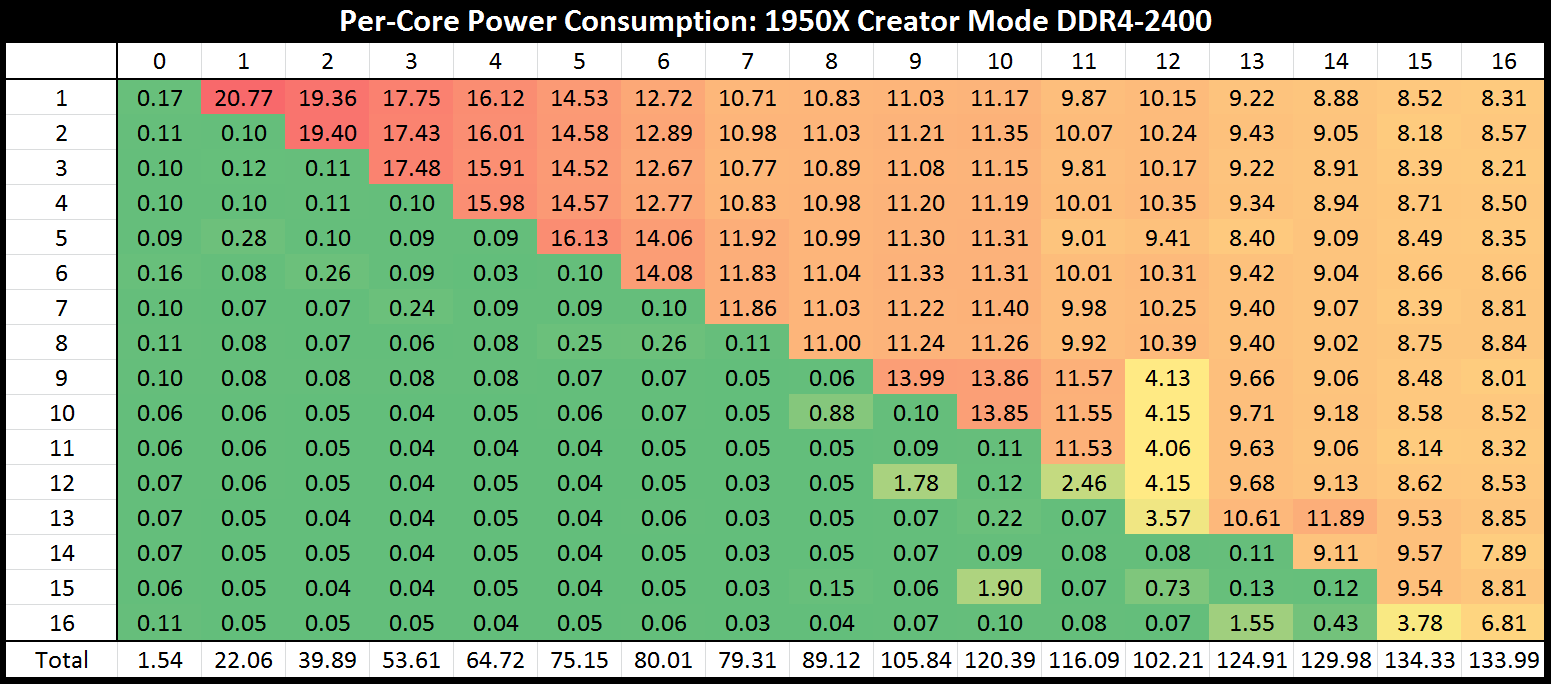
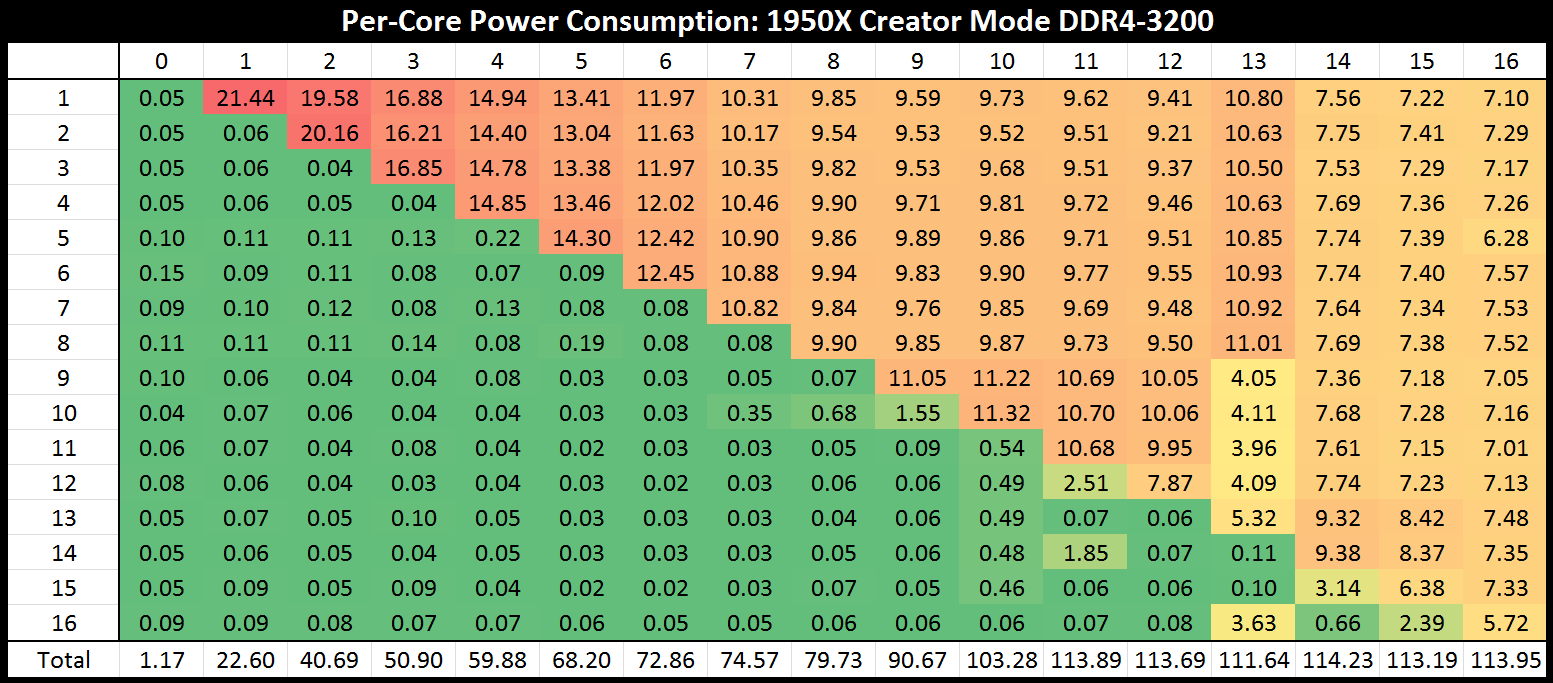








347 Comments
View All Comments
Zoeff - Thursday, August 10, 2017 - link
Yeeeees! Thanks for the review! I was hoping there'd be an embargo lift at this hour. :DZingam - Sunday, August 13, 2017 - link
The best CPUs for MineSweeper in 2017 in a single article!!!!NikosD - Monday, August 14, 2017 - link
Anandtech is simply wrong regarding Game mode or "Legacy Compatibility Mode" as you prefer to call it and make jokes about it.It seems that you don't know what ALL other reviewers say that Game mode doesn't set SMT off, but it disables one die.
So, Threadripper doesn't become a 16C/16T CPU after enabling Game mode as you say, but a 8C/16T CPU like ALL other reviewers say.
Go read Tom's Hardware which says that Game mode executes "bcdedit /set numproc XX" in order to cut 8 cores and shrink the CPU to one die (8C/16T) but because that's a software restriction the memory and PCIe controller of the second die is still alive, giving Quad Channel memory support and full 60+4 PCIe lanes even in Game mode.
And you thought you are smart and funny regarding your Game mode comments...
monglerbongler - Tuesday, July 10, 2018 - link
real renderers buy epyc or xeon. Either they have the money because its corporate money, they have the money because it comes from plebs paying someone comission/subscription money, or they have the money because they are plebs buying pre-built workstations.craptasticlemon - Wednesday, September 13, 2017 - link
Here's the real Threadripper review:AMD thrashes Intel i9 in every possible way, smushes it's puny ass into the dirt, and dances on the grave for the coup de gras. It is very entertaining to watch the paid Intel lackeys here try to paper over what is clearly a superior product. Keep up with the gaming scores guys, like anyone is buying this for gaming. I for one am looking forward to those delicious 40% faster render times, for the same price as the Intel space heater.
alysdexia - Thursday, April 18, 2019 - link
its, shit-headswifter
Dr. Swag - Thursday, August 10, 2017 - link
In paragraph two you say Ryzen 3 has double the threads of i3, I think you mean to say double the cores :)IanHagen - Thursday, August 10, 2017 - link
Not trying to nitpick or imply anything but... There is a logical reason for Threadripper getting five pages of gaming performance review and Skylake-X not even appearing on the charts more than a month after it was reviewed?Ian Cutress - Thursday, August 10, 2017 - link
Bottom of page one.IanHagen - Thursday, August 10, 2017 - link
With all due respect Mr. Cutress, "circumstances beyond our control" and "odd BIOS/firmware gaming results" didn't prevent anyone from bashing Ryzen for its gaming performance on its debut.